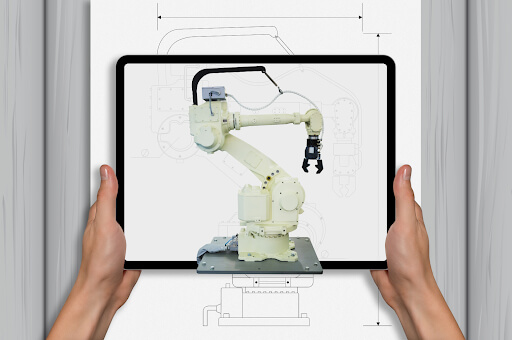 1-800-805-5783
1-800-805-5783 
The healthcare industry is transforming remarkably, driven by technological advancements and a growing demand for personalized patient experiences. Augmented Reality (AR) has emerged as a powerful tool in healthcare, potentially revolutionizing various aspects of medical practice, from surgical procedures to patient education and diagnosis. By integrating digital content into the real world, AR in healthcare is reshaping how services are delivered, improving efficiency, accuracy, and overall patient care.
One of the most significant applications of AR in healthcare is in surgical procedures. Surgeons can now wear AR headsets, allowing them to visualize critical information without detaching from the task at hand. By superimposing computer-generated imagery onto the real-world view, AR enables surgeons to see patient imagery, such as CT scans, in real time during the operation. This technology gives surgeons precise guidance and enhances their ability to make accurate decisions, improving surgical outcomes. Additionally, AR combined with AI software can process vast amounts of data and provide on-the-fly diagnoses or procedural suggestions directly in the surgeon’s field of view.
Augmented reality in the medical field has given rise to AR tools developed to superimpose visuals on patients, enhancing the delivery of safer and more efficient care beyond the operating room. For example, nursing staff can use AR overlays to easily identify the right vein when administering medicine, reducing the need for trial and error. This not only improves patient comfort but also minimizes the risk of complications. Furthermore, AR can help patients visualize their bodies, understand their conditions, and gain insights into specific procedures. By personalizing the patient experience with AI, healthcare providers can tailor visualizations to individual health data, empowering patients to take an active role in their own care.

AR in healthcare plays a crucial role in improving patient diagnosis, particularly when verbal descriptions are inadequate. Patients often struggle to accurately describe their symptoms, leading to delays in diagnosis and treatment. AR can help bridge this communication gap by allowing patients to visually compare their symptoms to different skin conditions or experience various eye conditions. This visual aid enhances the patient’s ability to accurately describe their concerns to healthcare providers, leading to more timely and accurate diagnoses.
AR, along with its counterpart, Virtual Reality (VR), has proven to be effective in pain management. Patients can be immersed in therapeutic environments controlled by healthcare professionals, distracting from pain and promoting relaxation. The FDA has already approved VR-based systems that use cognitive behavioral therapy to help patients cope with chronic pain. Similarly, AR can be used during physical therapy sessions to minimize discomfort and improve patient engagement. By integrating data on the patient’s specific pain, AI can personalize the pain management experience, optimizing treatment outcomes.
AR in healthcare has become invaluable for healthcare education and training. Medical students and professionals can explore the human body, practice procedures, and learn new techniques in virtualized environments resembling real-world scenarios. AI technology enhances these training experiences by providing real-time feedback and adapting the virtual environment based on user actions. This interactive and immersive learning approach facilitates a deeper understanding of complex medical concepts and prepares healthcare professionals for real-world practice. Furthermore, AR in healthcare allows for remote collaboration, enabling students in a classroom to observe and learn from their peers wearing AR glasses.

While we have only scratched the surface of what AR and AI can accomplish in healthcare, the possibilities for future innovations are immense. AR and AI have the potential to transform healthcare delivery, from improving surgical precision and patient education to enhancing diagnostics and pain management. The integration of AR technology with online collaboration tools enables healthcare professionals to consult with each other remotely, providing guidance and support even when physically distant. Pharmaceutical and genomics companies can leverage AR and AI to visualize, analyze, and develop new drugs, viruses, and therapies, opening new medical research and development frontiers.
To fully harness the benefits of AR in healthcare, organizations must invest in education and training to familiarize medical staff with AR-supported tools. Implementing small-scale pilot projects can help mitigate the fear of change and ensure that healthcare providers stay up-to-date with the evolving AR industry. By embracing AR and AI, healthcare organizations can enhance patient care, improve efficiency, and pave the way for a healthier future.
Augmented Reality (AR) is revolutionizing the healthcare industry, providing unprecedented opportunities to improve patient care, enhance surgical procedures, and transform medical training. Integrating AR technology with AI enables healthcare professionals to visualize critical information, personalize patient experiences, and make more accurate diagnoses. From surgical visualization and patient education to pain management and immersive training, the applications of AR in healthcare are diverse and promising. While challenges such as the cost of AR products and data security concerns remain, the potential benefits outweigh the obstacles. The global market for AR in healthcare is projected to experience significant growth in the coming years, driven by increased adoption, investments, and technological advancements. As the healthcare industry continues to embrace digital transformation, AR will play a vital role in shaping the future of medicine, delivering better, safer, and more personalized care to patients worldwide.